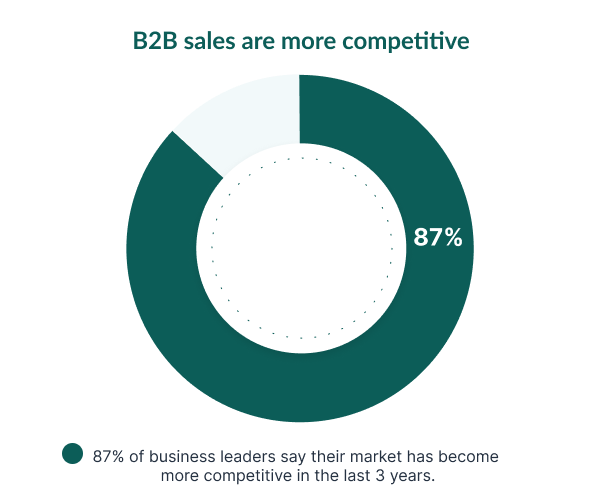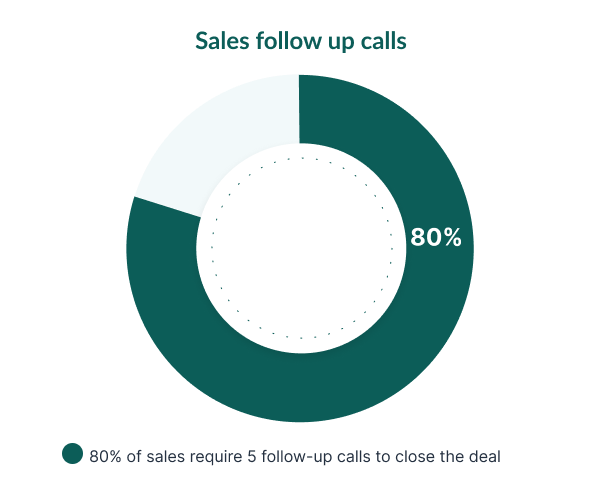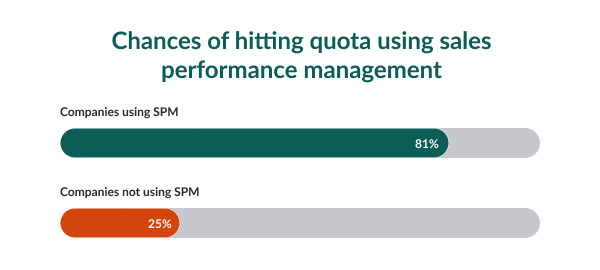It’s going to be a tough year for B2B sales teams.
Why?
- Sales cycles have increased by 32% compared to last year
- The tech sector saw 240,000 layoffs in 2023 as companies cut budgets
- There are now on average 7 decision-makers involved in the B2B buying process
To make matters worse:
Competition is at an all-time high as 87% of business leaders believe that their market has become more competitive in the last 3 years.

As a sales manager, you need to look past all of that. Why? Because you still have a team to lead, quotas to fill, and revenue targets to hit!
And for that, you need to build a winning sales team.
Without one, you’re likely to face a year of:
- Fewer sales
- Missed revenue forecasts
- Redundancies
In this article, we’ll share what makes a winning sales team and how you can create one, which includes three stages: build, develop and measure.
What makes a winning sales team?
It’s obvious - a winning sales team in B2B will help you close more sales and meet revenue targets.
The best performing B2B sales teams have high integrity and are focused on creating sustainable relationships that your company can retain and expand in the future.
There’s no room for short-term thinking or “going after a quick buck” in a winning sales team – there’s only high-quality long-term growth.
Winning teams do this by universally adopting a sales methodology that has been created by leaders in their company.
This methodology should align with wider company values and be easily measurable, whilst also concentrating on efficiently closing deals with high-quality customers.
Your specific sales methodology may vary depending on the needs of your company, but it’s likely to include things like:
- A customer-centric approach that puts prospective customers first
- The use of consultative selling to find the ideal solution for prospects
- Concentrating on a well-defined ICP to avoid time-wasting and bad fit customers
Once you’ve created your sales methodology, there are 3 key phases you’ll need to go through to form your winning sales team:

So, let’s take a closer look at the first phase of activity you’ll need to create a winning sales team - Build: hiring and onboarding your sales team.
Phase one: Build
Phase one of creating your winning sales team involves how efficiently and effectively you can bring the right people into your team and quickly get them up to speed.
Make sure you hire the right people
On average companies have just 3 available and qualified candidates to choose from for each B2B sales job they have.
However, research shows that it can cost as much as $115,000 to replace a salesperson after a bad hire.

So, before you make your next hire, think about how they’re going to fit in and complement (or improve) the team you already have in place.
Here are the main questions you should ask yourself when hiring for your sales team:
- Do they have the right mix of experience and potential?
- How will they blend with your current team culture?
- How will they add to your team culture?
- Do they come at this role with different perspectives?
- Can their experience contribute to improving your existing team?
Once you’ve got the right people on your sales team, you can start to think about how best to set them up for success with an onboarding and training program.
Train and onboard your entire team
Let’s admit – new sales reps won’t make an impact from day one. Research shows that it will take them 5 months to be effective team members.
The good news is that offering quality training and onboarding during this period means your sales team will improve their ability to hit quota by 16.2%.
Training isn’t just a consideration. It’s a must-have!
For 49% of high-performing sales reps, access to training is a significant factor in their decision to take a new sales job.
With that in mind, 3 types of training you should consider for your new sales hires include:
- Product knowledge and company values/orientation
- Skills development training to make them even better
- Mentoring and upskilling programs to drive their career development
It’s important to note that training doesn’t just stop when you’ve hired a new employee.
The most successful sales teams are always reviewing results and considering how they can be improved – and training and onboarding are no exception.
In the next phase, we’ll be looking at how you can develop your winning sales team further to help them succeed during these tough economic times.
Phase two: Develop
As a sales manager you need to give your sales team every opportunity to succeed - and a key part of this is creating the right environment for them to thrive in.
Phase two of your approach to creating a winning sales team looks at how you can develop the right culture, set achievable goals, and encourage a focused and consistent approach to sales.
Take the time to develop a winning culture
Team culture can be difficult to pin down – but when it comes to sales, it’s easy to measure in terms of results and a dynamic attitude of “winning” amongst your team.
This culture of top sales performance is one that you should look to instill in your team and encourage it through some friendly competition.
Top performance can be measured, but it can also be taught, by mirroring the efforts of others and changing behaviors.
For example, 76% of top-performing salespeople research their prospects before reaching out. You can add this as a step in your sales process and document in a CRM – meaning every sales rep researches a prospect before they reach out.

By taking small steps to incrementally change behavior, you can start to build a winning culture that efficiently hits sales targets.
Areas of behavior you can focus on to create “an elite mentality” in your sales team include:
- Performance – encourage them to hit and exceed targets every time
- Teamwork – the best work comes from collaboration and support
- Integrity – behave honestly and in the best interests of the company & customers
- Feedback – be open to (and act on) feedback to make iterative improvements
- Professional development – always strive to be better than you were yesterday
- Alignment – don’t create silos, learn to work with other teams like marketing
To reinforce the behaviors you want to encourage as part of your winning sales culture, you can track and measure them in your sales CRM as KPI’s - to keep everyone accountable.
Set everyone up for success with clear goals
70% of sales leaders suggest that the goals they set for their sales team heavily influence the performance of individual sales reps.
However, only 46% of sales reps, globally, are currently meeting their quota. This means you need to make sure the goals you set are clear and attainable.
So, what are some of the considerations you should make when setting goals for your sales team?
- Make them SMART – One of the oldest acronyms in the book, SMART stands for Specific, Measurable (via your CRM), Achievable, Relevant, and Time-bound. This framework ensures that what you’re asking of your sales team is easily understood.
- Not all performance is equal – Sales managers should look at each role (or person) in their sales team and set appropriate quotas individually for them, as opposed to a “one size fits all” approach.
To illustrate this, on average, 65% of account executives focused on “outside” sales are hitting their quota, vs. 55% for “inside” sales reps.
- Personal goals for professionals – Another way to get the best out of your team is to support them in their professional development. This means giving them goals to work towards that will improve their performance, put them in line for promotion, or take on additional skills to enhance their role.
- Get everyone on the same page – You need to make sure that the goals you’re setting for your sales team are going to have a big impact. This means aligning the goals you’re setting for your team, and individuals in your team, against wider company objectives.
- Keep reviewing them – You should take time to regularly review progress against the goals you set, identify any “blockers” you can fix, and if necessary, adjust the targets to keep them challenging and attainable.
We recommend using a CRM platform to monitor your team’s performance against the goals they’ve been set.
But, if after reviewing the data in your CRM, you still find that your sales team is struggling to perform, then you may need to go back to basics.
Get the sales basics right
There is no substitute for doing the basic things right, every time. Because there’s a power in being consistent.
Let’s start with the most basic thing – a follow-up! Did you know that 48% of salespeople never follow up.
Following up with prospects is one the foundations of good sales, with 80% of closed deals requiring at least 5 follow-ups.
So, no follow-ups – no chance!

The good news is that follow-ups are easy to record and track in your CRM.
The most successful sales teams use their CRM to track leads and log updates, because they know how vital this basic information is.
Another sales basic is to follow up on enquiries, and do it quickly.
Surprisingly, only 7% of companies respond to a prospect’s form submission within 5 minutes, even though buyers often choose the supplier who contacts them first.
By encouraging your sales team to log follow-ups and focus on quick response times in your CRM, you can use the data collected as the basis for KPIs to keep your sales team on track.
Now, let’s move on to discuss phase 3: measuring and analyzing results.
Phase three: Measure & Analyze
One of your key responsibilities is to understand how your team is performing and coach them as needed to hit their sales targets.
Let’s see how you can give your team the right tools for the job, how you can monitor their performance, and then analyze sales-related data to inform your next steps.
Give your team the right tools
Lost productivity and poorly managed leads in sales teams mean that companies lose more than $1 trillion every year.
One of the key tools you should be looking at for your team is a CRM solution. In fact, 91% of companies with ten or more employees already use a CRM.

The best CRM systems (like SuperOffice) are designed to support the sales process.
Using a CRM offers several advantages that empower sales teams to close more deals, including sales intelligence, CPQ, dashboards, reporting, and, of course, mobile CRM.
65% of companies who use a CRM with mobile capabilities are achieving or exceeding their sales quotas, vs. just 22% who reach the same targets without mobile capabilities.
When you consider CRM as a platform, rather than just an isolated piece of software, it also enables you to invest in and integrate with other systems like:
- Sales enablement
- Market research
- Data analytics
- Customer service
- and more …
This helps you to create a seamless suite of tools that will dramatically boost the efficiency of your sales team and help you meet and exceed your sales targets.
When you place a CRM at the heart of your business, how do you use it to monitor their performance? Let’s take a closer look.
Keep an eye on performance and give regular feedback
Companies who regularly undertake sales performance management see more than 81% of their sales reps achieving quota and typically generate 3X higher annual revenue.
Compare this to companies that don’t utilize sales performance management, where only 25% of their reps manage to hit their sales quotas.

Most sales teams track 6–10 sales performance metrics, with popular metrics you can track in a CRM system including:

Tracking metrics isn’t an isolated event.
As a sales manager, you should be monitoring the performance of your team at least daily, and in some cases multiple times a day.
As well as sales metrics, you can also use your CRM to track KPIs that indicate how your team is performing against other expectations of their role, for example:
- Follow-up calls made
- Number of meetings booked
- Lead response time
Your CRM will be fully equipped with a host of performance reports you’ll want to regularly review.
As a SuperOffice customer, you can also create custom dashboards to help you review the metrics and KPIs that matter most.
Analyze and decide
But good sales managers don’t just measure their team's results – they also analyze and act on them!
This analysis supports sales managers in making decisions on which strategies to use to help them hit their targets.
Put simply, depending on the results of the metrics and KPIs they’re monitoring in their CRM, sales managers will have one of 3 choices to make.
- Rinse and repeat – if everything is going well, your team is on track to hit targets, and there is no cause for concern, then continue as you are.
- Make adjustments – if results aren’t where you need them to be, it’s time to make adjustments. Using the data you’ve analyzed in your CRM you should be able to spot areas for improvement, for example, follow-up volume, lead response time, etc.
- Scale up – if you find that results are consistently hitting or exceeding your targets, and you’ve successfully built a winning sales team, it may be time to consider scaling up that team by revisiting phases one and two with new recruits.
The good news is that using a CRM platform makes this process much easier!
Modern CRM platforms are designed to support sales managers to make quick and well-informed decisions.
Meanwhile, real-time reporting means you can make your sales management more agile, basing your actions on data, not guesses – an essential part of creating a winning sales team.
Conclusion
Creating a winning sales team is a huge advantage for any business.
And it’s even more important in 2024.
It starts by hiring the right sales reps and then training them – aka setting them up for success. Next, you need to develop a winning culture and create clear goals. Just don’t forget the often-overlooked basics.
Lastly, you need to empower your team by giving them the right tools, like a CRM, and then using the data and insights in a CRM to track their performance, give regular feedback and improve.
Looking for a CRM platform to support your winning sales team?
With SuperOffice, you get access to:
- Powerful CRM software to manage your entire pipeline
- Mobile CRM options to help you close more deals “on the go”
- Guided sales playbooks to deliver a consistent sales methodology
- Custom dashboards and reporting to help you uncover sales performance
- and much more…
Try SuperOffice and start managing all your sales, marketing, and support relationships from one unified platform, helping you close more deals with a best-in-class experience.



